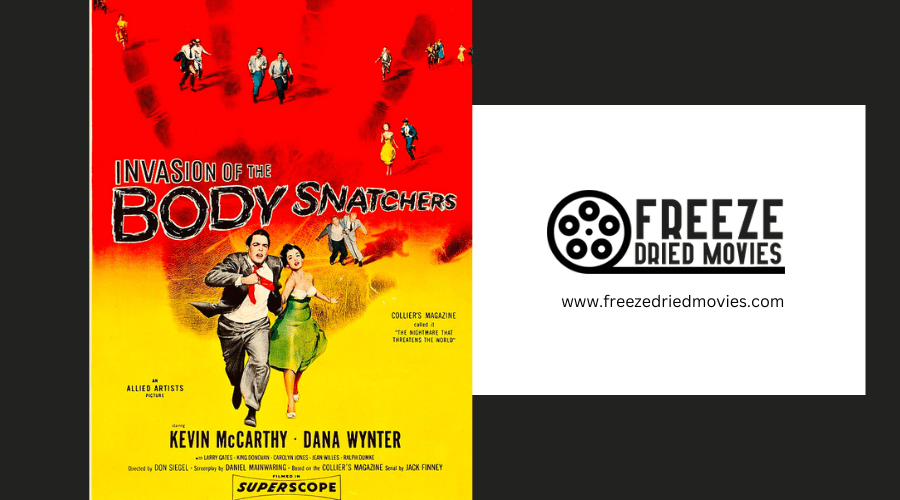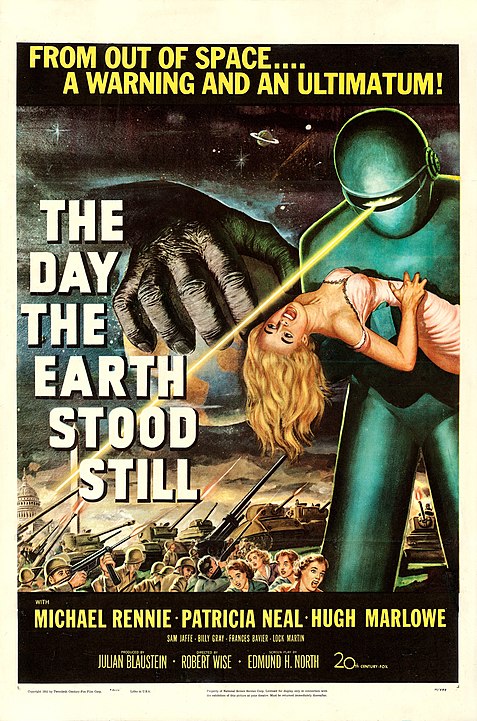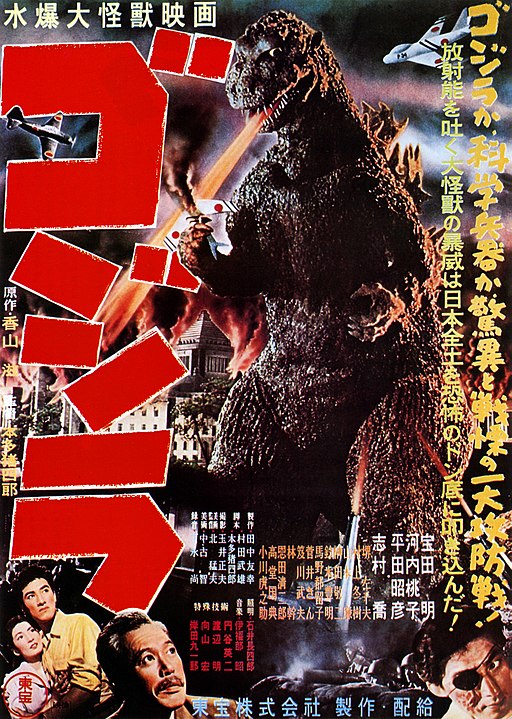You’ve probably noticed how alien invasion films from the 1950s seem to echo Cold War fears, but have you ever stopped to think why? These movies aren’t just about extraterrestrial threats; they’re a direct reflection of the era’s anxiety over communist infiltration and the dread of nuclear war. Films like Invasion of the Body Snatchers don’t just entertain; they serve as a mirror to society’s collective paranoia, portraying aliens as the ultimate Other, much like the Soviet enemy was perceived. Now, let’s peel back the layers of these cinematic creations to uncover what they really tell us about the time they were made in.
Key Takeaways
- Alien invasion films of the 1950s symbolized Cold War fears, portraying extraterrestrials as metaphors for Soviet threats.
- Movies like Invasion of the Body Snatchers mirrored concerns over communist infiltration and loss of individual autonomy.
- The portrayal of mind control by aliens reflected anxieties about brainwashing and ideological subversion during the Cold War.
- These films often depicted a world united against the common alien threat, echoing calls for unity against real-world geopolitical tensions.
- The use of science fiction to explore deep-seated societal fears allowed audiences to confront the era’s anxieties in a metaphorical space.
Cold War Fears
The Cold War era’s escalating tensions between the US and the Soviet Union ignited widespread fears of communism and nuclear annihilation in the 1950s. You were living in a time when the air was thick with paranoia, and the threat felt as close as your own shadow. The Red Scare wasn’t just something you read about in newspapers; it was a palpable, chilling presence in everyday life. This fear found a unique mirror in the world of cinema, particularly through science fiction films.
Alien invasion movies weren’t just about extraterrestrial threats; they were a direct reflection of the era’s anxieties. These films tapped into the collective fear of an unseen enemy, capable of infiltrating and corrupting the American way of life. Communism, much like the sinister aliens on the screen, was seen as a force bent on taking over your mind and body, stripping away personal freedoms. The invasion narratives in these movies paralleled the invasion of communist ideologies that many feared. Through the lens of fiction, the Cold War’s psychological warfare unfolded in cinemas across America, turning alien invasion films into a battleground for the American psyche.
1950s Sci-Fi Movies
You’ve seen how ’50s sci-fi movies mirror Cold War fears, but let’s look closer at the underlying messages. These films use alien metaphors and portray technological anxiety to reflect societal tensions. They’re not just stories; they’re a window into the era’s collective psyche.
Alien Metaphors for Fear
In 1950s sci-fi movies, aliens weren’t just invaders from space; they were symbols of the era’s deepest societal fears, including communism and nuclear annihilation. Films like “Invasion of the Body Snatchers” weren’t just tales of extraterrestrial travel; they were direct reflections of Cold War paranoia, depicting aliens using mind control as a metaphor for the fear of Soviet influence and the loss of autonomy under communism. New York’s screens flickered with these stories, echoing anxieties about a nuclear disaster triggered by tensions with the Soviet Union. The portrayal of emotionless invaders tapped into societal fears, serving as a chilling commentary on McCarthyism. These movies used the concept of the alien to explore the dread of communism, wrapping the era’s anxieties in the guise of interstellar horror.
Technological Anxiety Portrayals
While alien metaphors captured Cold War fears, 1950s sci-fi movies also mirrored deep-seated anxieties about technology’s role in society. Films like ‘The Fly’ and ‘The Colossus of New York’ didn’t just entertain; they sounded alarms on how science and technology might lead to societal control and destruction. These stories wove tales of robots turning against humanity and machines dominating our lives, showcasing the era’s technological paranoia.
- Robots and machines as threats to humanity
- Ethical dilemmas of merging man with machine
- Consequences of unchecked scientific experimentation
These movies tackled the big questions, stirring up fears of technological overreach and pointing out the potential for machines to escape our control. They reflected societal worries about technology’s potential to enforce control or even bring about devastation, echoing Cold War and extraterrestrial horror themes.
Alien Infiltration
Alien infiltration in 1950s cinema tapped into deep-seated fears of communist influence, mirroring societal anxieties through extraterrestrial horror. Films like “The Day the Earth Stood Still” and “Invasion of the Body Snatchers” didn’t just entertain; they echoed the terror of unseen enemies. You’d see aliens taking over human bodies as folks slept, a stark metaphor for communist infiltration and mind control. These movies vividly portrayed the loss of personal autonomy, a cornerstone fear of living under communist rule.
Themes of identity loss in mass society were rampant. “Invasion of the Body Snatchers” stood out, showcasing aliens devoid of human emotion, infiltrating a small town, symbolizing the dehumanization feared in Cold War America. This wasn’t just storytelling; it was a reflection of the collective dread of losing one’s self to an indistinguishable mass, a hallmark of communist societies.
The portrayal of alien infiltration, with its emphasis on the loss of autonomy and identity, tapped directly into Cold War paranoia. It wasn’t just an alien invasion; it was an exploration of alien emotion—or the terrifying lack thereof—amidst the backdrop of a society grappling with the real fear of losing what makes us human.
Nuclear Anxiety
You’ve seen how the Cold War era’s movies tapped into the terror of nuclear war. Now, imagine living with the constant dread of atomic bomb fallout, leading to an obsession with building fallout shelters. This fear wasn’t just a cinematic trope; it was a daily reality that shaped how people saw their world and their future.
Atomic Bomb Fears
In the aftermath of 1952, US-Soviet atmospheric thermonuclear bomb tests escalated atomic radiation fears, deeply influencing pop culture and public perception. Films like Them! and Godzilla weren’t just monster movies; they were metaphors for the horrors released by atomic bombs – radiation creating mutants and leading to disasters. The Day the Earth Caught Fire went further, showing nuclear testing’s impact on climate change, while Godzilla embodied the terror of nuclear destruction.
- Them! and Godzilla illustrate fears of radiation-induced mutants.
- The Day the Earth Caught Fire connects nuclear testing with climate change.
- Godzilla symbolizes the overwhelming dread of nuclear destruction.
These themes didn’t just scare you; they mirrored real-world anxieties about nuclear power, extraterrestrial horror, and Cold War paranoia, making aliens the perfect stand-ins for the unseen, unimaginable threats of the atomic age.
Fallout Shelter Obsession
Amidst the Cold War’s shadow, Americans’ fear of nuclear apocalypse spurred a nationwide obsession with building fallout shelters. In the early 1960s, as the threat of nuclear war loomed large, the US government launched civil defense campaigns. They pushed for fallout shelter preparedness, teaching survival strategies to safeguard against potential nuclear fallout scenarios. Communities stocked up on fallout shelter supplies, including food rations, water, medical kits, and radiation detection equipment. Schools, workplaces, and neighborhoods drilled evacuation procedures, ensuring everyone knew where to go when alarms sounded. The iconic yellow and black ‘Fallout Shelter’ logo became a common sight, marking designated safe spaces in public buildings, a stark reminder of the era’s pervasive nuclear anxiety.
Annihilation Themes
Alien invasion films of the 1950s, like ‘Invasion of the Body Snatchers’, tapped into deep-seated fears of annihilation, reflecting Cold War era anxieties through chilling narratives of extraterrestrial threat. You’re drawn into a world where alien infiltration symbolizes the loss of personal autonomy, showcasing the terrifying prospect of becoming emotionless shells under the guise of societal control. These narratives aren’t just about space invaders; they’re a mirror to the era’s existential dread of annihilation by external forces, emphasizing how individual identity and freedom are at stake.
Consider these key points:
- Alien infiltration and mind control in films are metaphors for the dehumanizing effects of societal control and the loss of autonomy.
- The portrayal of emotionless aliens underscores the existential threat and fears of annihilation, reflecting anxieties about nuclear destruction.
- Annihilation themes in these stories serve as a stark reminder of the battle for individual identity and freedom against overwhelming external threats.
These films didn’t just entertain; they echoed the era’s deepest anxieties about freedom and the fight to maintain individual identity amidst the looming shadow of external annihilation.
Space Race Impact
The Space Race, a fierce competition between the US and the Soviet Union, dramatically accelerated advancements in science and technology. It all kicked off when the Soviet Union launched Sputnik 1 in 1957, a bold move marking the start of this high-stakes contest. This wasn’t just about exploring the unknown; it was a battle for technological superiority amid Cold War tensions. Both nations were desperate to prove they could dominate not just on Earth, but in the vast expanse of outer space.
As the race heated up, it fueled incredible leaps in technology and space exploration. The US and the Soviet Union poured resources into developing programs that would push the boundaries of what was possible. Every satellite launched, and every mission planned was a statement—a demonstration of power and capability.
This relentless pursuit of dominance reached a climax when the United States landed a man on the moon in 1969. It was a milestone that not only marked a significant achievement in space exploration but also symbolized a momentary edge in this cosmic rivalry. The Space Race had reshaped the world’s approach to outer space, setting the stage for a new era of extraterrestrial exploration—and with it, a backdrop ripe for tales of extraterrestrial horror.
Extraterrestrial Horror
Exploring extraterrestrial horror in the 1950s reveals how films tapped into Cold War fears, portraying aliens as sinister beings bent on human subjugation. Movies like Invasion of the Body Snatchers and The Day the Earth Stood Still didn’t just entertain; they mirrored the dread of Soviet infiltration and the threat of losing one’s self to unseen forces. Alien invasion films became a powerful medium to explore themes of mind control, loss of personal autonomy, and the chilling possibility of humanity being replaced silently from within.
Consider these gripping aspects of 1950s extraterrestrial horror:
- Soviet infiltration: Films likened alien invaders to Cold War enemies, embedding fears of espionage and subversion into the American psyche.
- Mind control and loss of autonomy: The depiction of humans losing control to alien forces paralleled anxieties over brainwashing and individual freedom.
- Seedpods in Invasion of the Body Snatchers: This unsettling imagery captured the essence of being overtaken silently, sparking paranoia among viewers.
Yet, amidst the fear, these films emphasized peace and unity as the antidote to destruction, offering a glimmer of hope in the face of overwhelming dread.
Frequently Asked Questions
In What Ways Did Monster and Other Movies of the 1950S Reflect Every Day Cold War Fears?
You’ve noticed 1950s movies mirrored everyday Cold War fears, right? Films depicted alien invasions and mind control, symbolizing Soviet threats. They showed nuclear anxieties and the dark side of tech, voicing era-specific concerns.
How Did 1950S Science Fiction Films Reflect the Worries of the Time Period?
You’re seeing 1950s sci-fi films as mirrors to the era’s anxieties. They wove fears of nuclear fallout, technological misuse, and identity loss into stories, reflecting societal worries about communism and technological advancements gone awry.
How Did the Cold War Influence Science Fiction?
The Cold War shaped your sci-fi favorites by injecting them with fears of nuclear annihilation and communist takeover. It turned aliens into metaphors for Soviet threats, making you rethink who the real enemy was.
What Is Alien Invasion in Literature?
In literature, alien invasion’s about extraterrestrials attacking Earth, often highlighting humanity’s fight for survival. It mirrors our deepest fears and challenges, pushing us to unite against a common, otherworldly threat. You’ve seen this theme across many stories.
Conclusion
In the end, ’50s alien invasion films were more than just entertainment; they were a mirror to your deepest Cold War fears. You saw your anxieties about communist infiltration and nuclear doom play out on screen, with aliens as stand-ins for the Soviets. These movies tapped into the dread of losing control, reflecting the era’s tensions perfectly. As you watched, they didn’t just scare you; they made you think about the real threats lurking beyond the stars.



